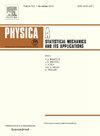社会依赖的传染模型
IF 2.8
3区 物理与天体物理
Q2 PHYSICS, MULTIDISCIPLINARY
Physica A: Statistical Mechanics and its Applications
Pub Date : 2024-11-23
DOI:10.1016/j.physa.2024.130247
引用次数: 0
摘要
经验证据表明,传染依赖于社会关系,不同的传染实体(如疾病或信息)的社会依赖程度各不相同。为了揭示社会依赖对传染动力学的影响,我们引入了社会依赖系数,并提出了一个具有非冗余影响记忆的传染模型,在简单传染和复杂传染之间架起桥梁。在这个模型中,个体存在于三种状态中的一种:易感、感染或康复。当易感个体接受的累积非冗余效应(由信念函数表示)超过其阈值时,易感个体就会被感染。通过渗流法和平均场理论,我们发现低社会依赖性可以扩大最终恢复种群的规模,但这种效应不是连续的。具体来说,社会依赖程度可以根据临界传播概率分为三个区间。在低依赖区间内,传染性实体能够以较低的传播概率广泛传播。在中等依赖区间内,临界传播概率随社会依赖程度逐步增大。在高依赖区间内,种群在任何传播概率下都不会发生大规模的传染病暴发。结果不受异构网络结构的定性影响,理论预测与仿真结果一致。本文章由计算机程序翻译,如有差异,请以英文原文为准。
The contagion model with social dependency
Empirical evidence demonstrates that contagion relies on social relationships, and the level of social dependency varies for different contagious entities (e.g., diseases or information). To unravel the influence of social dependency on the contagion dynamics, we introduce a social dependency coefficient and present a contagion model with the memory of non-redundant influence on complex networks, which bridges the simple and complex contagions. In this model, individuals exist in one of three states: susceptible, infected, or recovered. Susceptible individuals become infected when the cumulative non-redundant effects they have received (represented by a belief function) exceed their thresholds. By percolation method and mean-field theory, we find that low social dependency can expand the size of final recovered population, yet this effect is not continuous. Specifically, the level of social dependency can be categorized into three intervals based on the critical transmission probability. In the low-dependency interval, contagious entities can spread widely at a low transmission probability. In the medium dependency interval, the critical transmission probability increases stepwise with the social dependency. In the high-dependency interval, the population is free from large outbreaks of contagion at any transmission probability. Besides, the results are not qualitatively affected by the heterogeneous network structure and the theoretical predictions are consistent with the simulation results.
求助全文
通过发布文献求助,成功后即可免费获取论文全文。
去求助
来源期刊
CiteScore
7.20
自引率
9.10%
发文量
852
审稿时长
6.6 months
期刊介绍:
Physica A: Statistical Mechanics and its Applications
Recognized by the European Physical Society
Physica A publishes research in the field of statistical mechanics and its applications.
Statistical mechanics sets out to explain the behaviour of macroscopic systems by studying the statistical properties of their microscopic constituents.
Applications of the techniques of statistical mechanics are widespread, and include: applications to physical systems such as solids, liquids and gases; applications to chemical and biological systems (colloids, interfaces, complex fluids, polymers and biopolymers, cell physics); and other interdisciplinary applications to for instance biological, economical and sociological systems.

 求助内容:
求助内容: 应助结果提醒方式:
应助结果提醒方式:


